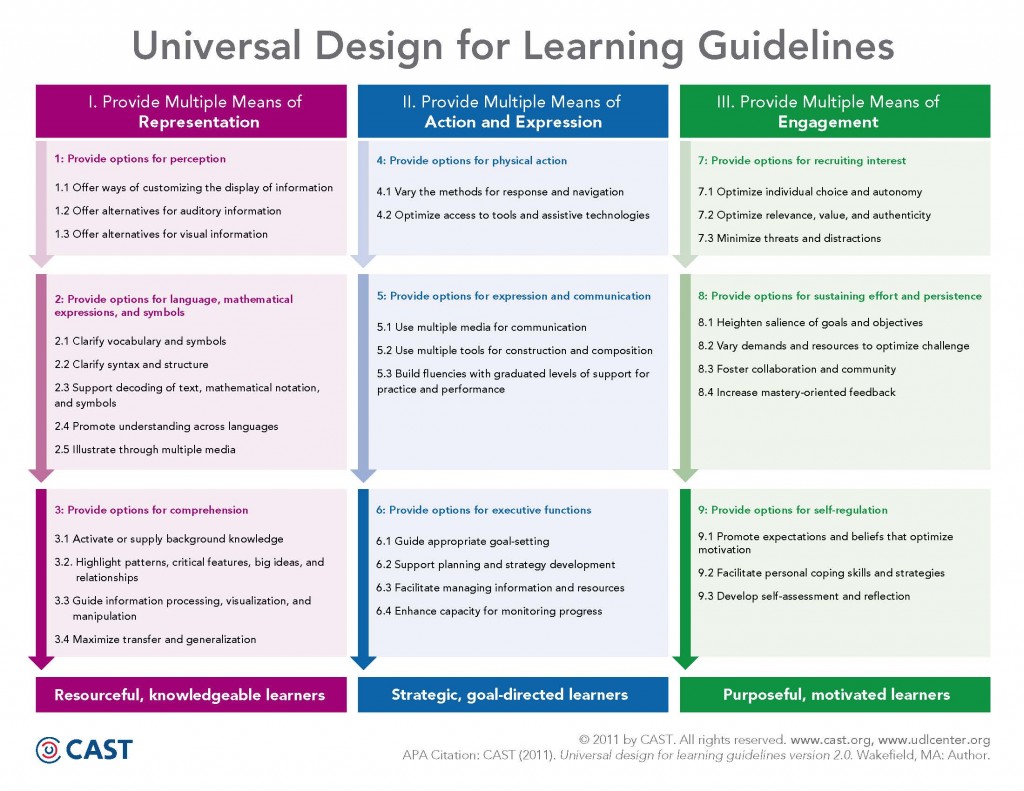
Use of technology to enhance learning, teaching and assessment should be considered and appropriate, and should never exclude any learner from engaging in the process. The burden of inclusivity lies with all staff, by curriculum design, and it should not be left to students to adapt.
Universal Design for Learning (UDL) is an educational framework based on research in the learning sciences, including cognitive neuroscience, that guides the development of flexible learning environments that can accommodate individual learning differences. (Rose & Meyer, 2002)
UDL is a set of principles for curriculum development that give all individuals equal opportunities to learn. It provides a blueprint for creating instructional goals, methods, materials, and assessments that work for everyone – not just a single, one-size-fits-all solution but rather flexible approaches that can be customised and adjusted for individual needs.
UDL at a Glance
Three primary principles, which are based on neuroscience research, guide UDL and provide the underlying framework for the Guidelines:
- Principle I: Provide Multiple Means of Representation (the ‘what’ of learning). Learners differ in the ways that they perceive and comprehend information that is presented to them.
- Principle II: Provide Multiple Means of Action and Expression (the ‘how’ of learning). Learners differ in the ways that they can navigate a learning environment and express what they know.
- Principle III: Provide Multiple Means of Engagement (the ‘why’ of learning). Affect represents a crucial element to learning, and learners differ markedly in the ways in which they can be engaged or motivated to learn.
 UDL Guidelines – Version 2.0: Download the UDL Guidelines [Word]: A complete narrative describing the context within which CAST developed the UDL Guidelines including explanations and examples of each principle and checkpoint.
UDL Guidelines – Version 2.0: Download the UDL Guidelines [Word]: A complete narrative describing the context within which CAST developed the UDL Guidelines including explanations and examples of each principle and checkpoint.
UDL & Technology
Good educators will always find ways to design curricula that meets the needs of all learners, whether they are using technology or not. However, considered and appropriate digital technologies applied using UDL principles can enable easier and more effective customisation of curricula for learners. Advances in technology have made “on-the-fly” individualisation of curricula possible in practical, cost-effective ways, and many of these technologies have built in supports, scaffolds, and challenges to help learners understand, navigate, and engage with the learning environment.
Learning and demonstrating effective uses of technology is itself an important instructional outcome. Digital Capabilities can be defined as the skills and/or competencies required for living, learning and working in a digital society. Even today’s students need support with some areas of digital capability, particularly in an academic context, so it’s important to make sure that these needs are met.
However, it is important to note that these technologies should not be considered to be the only way to implement UDL. The goal of UDL is to create environments in which everyone will have the opportunity to become expert learners, and the means to get there, be it tech or non-tech, should be flexible.
It is also important to point out that simply using technology in the classroom should not be considered implementation of UDL. Using technology does not necessarily enhance learning, and many technologies have the same accessibility problems that non-tech options might have. Technology needs to be carefully planned into the curriculum as a way to achieve the goals. The Technology Enhanced Learning (TEL) Handbook is designed to guide staff in the considered and appropriate application of technology to enhance student engagement in learning, teaching, and assessment at York St John (YSJ).
In short, technology is not synonymous with UDL, but it can play a valuable role in its implementation and conceptualisation.
More information about UDL can be found at http://www.udlcenter.org/
Through engagement with inclusivity and accessibility issues, and active consideration of what and how you use technology to facilitate learning and teaching, you will be aligning your practice to the UK Professional Standards Framework (UKPSF). In particular the Professional Values and dimensions V1: Respect individual learners and diverse learning communities and V2: Promote participation in higher education and equality of opportunity for learners.
Download an Educators Worksheet for the UDL Guidelines [Word]: A worksheet listing the UDL principles and checkpoints with space for note-taking.
Does your curriculum address the principles of UDL? Are you providing multiple means of Representation, Action & Expression, and Engagement? Are you reflecting on how you can improve inclusivity in your curriculum?
References
Rose, DH, & Meyer, A (2002) Teaching Every Student in the Digital Age: Universal Design for Learning. Alexandria, VA: ASCD.

0 responses on "Universal Design for Learning (UDL)"